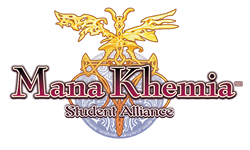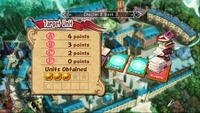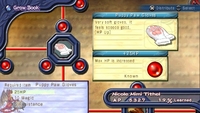|
|

|
PLATFORM
|
PSP
|
BATTLE SYSTEM
|

|
INTERACTION
|

|
ORIGINALITY
|

|
STORY
|

|
MUSIC & SOUND
|

|
VISUALS
|

|
CHALLENGE
|
Unbalanced
|
COMPLETION TIME
|
40-60 Hours
|
|
OVERALL

|
- Awful, awful lag
- Too many frequent load screens
+ Combat progressively grows
+ Solid sound and music
+ Fun, simple alchemy system
- Clichéd characters and plot
|
Click here for scoring definitions
|
|
|
In early 2008, NISA squeezed out Mana Khemia ~ Alchemists of Al-Revis ~ on the PS2. Mana Khemia is a mini-spin-off series to Gust's long running Atelier series and acts as the ninth game in the series due to the codename Project A9. Like other Atelier games, Mana Khemia focuses on alchemy and traditional turn-based combat, however, it also deals with the exploits of alchemists-in-training rather than young-but-learned alchemists. Fast forward a year later, and Mana Khemia returns to the west in a slightly altered form. Mana Khemia: Student Alliance for the PSP takes the PS2 version and shrinks it down for handheld fans, or it attempts to do so.
One of the key problems of Student Alliance is the technical gremlins. From the moment the game starts, a frequent series of load screens bombards the player. Every place and screen must be loaded separately, and many times two load screens pop up while heading deeper into a dungeon or returning to school. When the game stops loading, a new set of issues arises in the form of frequent lag. Opening menus almost always meets with slowdown, but lag can occur nearly anytime without just cause.
On a lighter note, Mana Khemia's combat evolves throughout the game. Originally, players will only have access to three characters and basic commands. As more characters join the party, new options open up. Six party members take part in battle: three active fighters and three backup supporters. When a support's bar fills, the support can be swapped out for an attacking or defending active party member. When attacking, multiple supports can join in to build up a series of attacks. Supports also recharge hit points and skill points, mitigating the need to frequently waste valuable healing items. Mid-game, the Variable Strike attack becomes available to make use of the six-man party. A four-man attack ending with the main character, Vayne, unleashes a fatal attack upon a single enemy. As enemies take more and more damage (particularly from opposing elemental attacks), the meter for Burst Mode fills. During Burst Mode, all attacks increase in potency, and a special command like "attack enemy weaknesses" or "attack continuously" flashes across the screen; completing the special objective during Burst Mode unlocks the ability for each character to access his or her Finishing Burst, dealing even greater damage. In the latter half of the game, new abilities add special effects to supports' attacks and defenses, adding extra depth for the final battles.
 If only school was so simple in real life.
If only school was so simple in real life.
|
|
As with other Atelier games, Mana Khemia focuses on an in-depth alchemy system. Hundreds of items, advanced ingredients, weapons, armors, and accessories can be synthesized by collecting the correct ingredients. Two types of synthesis exist: one for items and ingredients and a separate system for gear. In game, two separate rooms exist for the two varieties of synthesis, and traveling from one of the rooms to another evokes the wrath of at least two load screens. In gear synthesis, all of the items are automatically combined, and each ingredient's unique principles get added to the final product, though players must select two to three of these principles. Item synthesis involves a fairly detailed little mini game for manipulating the synthesis's alchemic number to determine the properties of the product. For example, getting a very low alchemic number for frozen sherbet will result in the "warm" property rather than the normal "cold" property.
Finally, synthesis affects character development. Each character has his own growth grid and an initial item that must be synthesized. Once synthesized, the spot on the chart will open up and the adjacent slot becomes available. As more items are synthesized, more and more squares open up. Each slot has a small selection of skills or stat increases that are purchased with ability points earned in battles. Unfortunately, missing just a single item synthesis prevents that path of the chart from ever being completed. Without a guide, many players may miss out on some of the more elusive recipes only available through sidequests or well hidden chests. Since characters do not level up beyond their advancement via growth charts, the game's difficulty could easily curb from missing a few recipes.
Mana Khemia's plot is fairly simple. Since the story focuses on the school life of freshman Vayne, Mana Khemia is mostly limited to character development as Vayne and his classmates grow up. Toward the end of the game, a more clichéd "chosen one" plot surfaces. The almost 180 flip in tone may unnerve some players who wanted the story to remain lighthearted. Mana Khemia's characters barely push the envelope in characterization; the antisocial kid, the perky girl, the muscle brain, et al are present in the cast. During scheduled free time, players can interact with Vayne's friends in order to learn more about their various quirks. These optional sidequests help round out a large portion of the cast, but players can only complete one character's quest per playthrough. Nevertheless, the sidequests are vital since they determine the ending of the game, so picking a favorite ally expands the overall plot.
 A necessary accessory for any aspiring furry.
A necessary accessory for any aspiring furry.
|
|
Visually, Mana Khemia lacks some finesse. The isometric environments look fine, but the view hampers gameplay. While exploring the various dungeons, players control Vayne and can attempt to avoid monster-encounters while roaming the dungeon. However, the only options available for dodging monsters usually involve carefully timed jumps. Combining the frequent lag and annoyance of platform jumping in isometric 3D leads to a failing formula. Outside of functionality, the art suffers from a lack of clarity. The character art shown during conversations comes off as very blurry or pixelated. While the intended visuals look decent, the overall execution fails.
Audibly, Mana Khemia tries to make up for the less stellar visuals. The soundtrack evolves during the game. In the beginning, sweet melodies and anthems bombard the players as they experience the lighthearted story of the new boy in school. As the story darkens a bit toward the end, most of the main melodies reflect the change in mood and add a welcome eeriness that strengthens the narrative. Each environment's theme greatly reflects the various atmospheres. In battle, an electric guitar controls the soundwaves. As cheesy as the rock anthems may be, the battle themes can help generate some energy during the later, intense battles. While used sparingly, Mana Khemia also features several hours of voiced over dialogue. The majority of the voices fit their respective characters perfectly, but a few of them may seem a tad bit strange or over the top. Likewise, most of the voice work for no-name background characters tends to come off as out-of-context screams or comments. Overall, the audio tackles its job with flying colors, but both aspects of the audio are mostly forgettable.
Mana Khemia clocks in around fifty hours. Skipping sidequests would only shave off about ten hours, so the game is naturally long. Of course, this means players will suffer through hundreds if not over a thousand technical errors. Aside from the technical gremlins, Mana Khemia: Student Alliance features new ad-hoc multiplayer battles with enemies that drop exclusive rare items and a "jump start" feature. By loading Mana Khemia onto the Memory Stick, jump start can bypass the use of the UMD, but the majority of Student Alliance's technically issues remain, rendering jump start useless.
In closing, Mana Khemia is a relatively solid game. Despite its numerous clichés and poor choices in graphic design, the game presents a fun and relatively addictive battle system and alchemy system. Backed with solid audio, Mana Khemia balances its cons with its pros. However, these remarks apply only for the PS2 version from 2008. 2009's Mana Khemia: Student Alliance deserves little praise. The port's errors transform an average game into an abomination barely worth touching. Atelier fans that have not yet checked out this spinoff series or readers interested in the combat and alchemy should avoid Student Alliance and hunt down the PS2 version.
Review Archives
|









